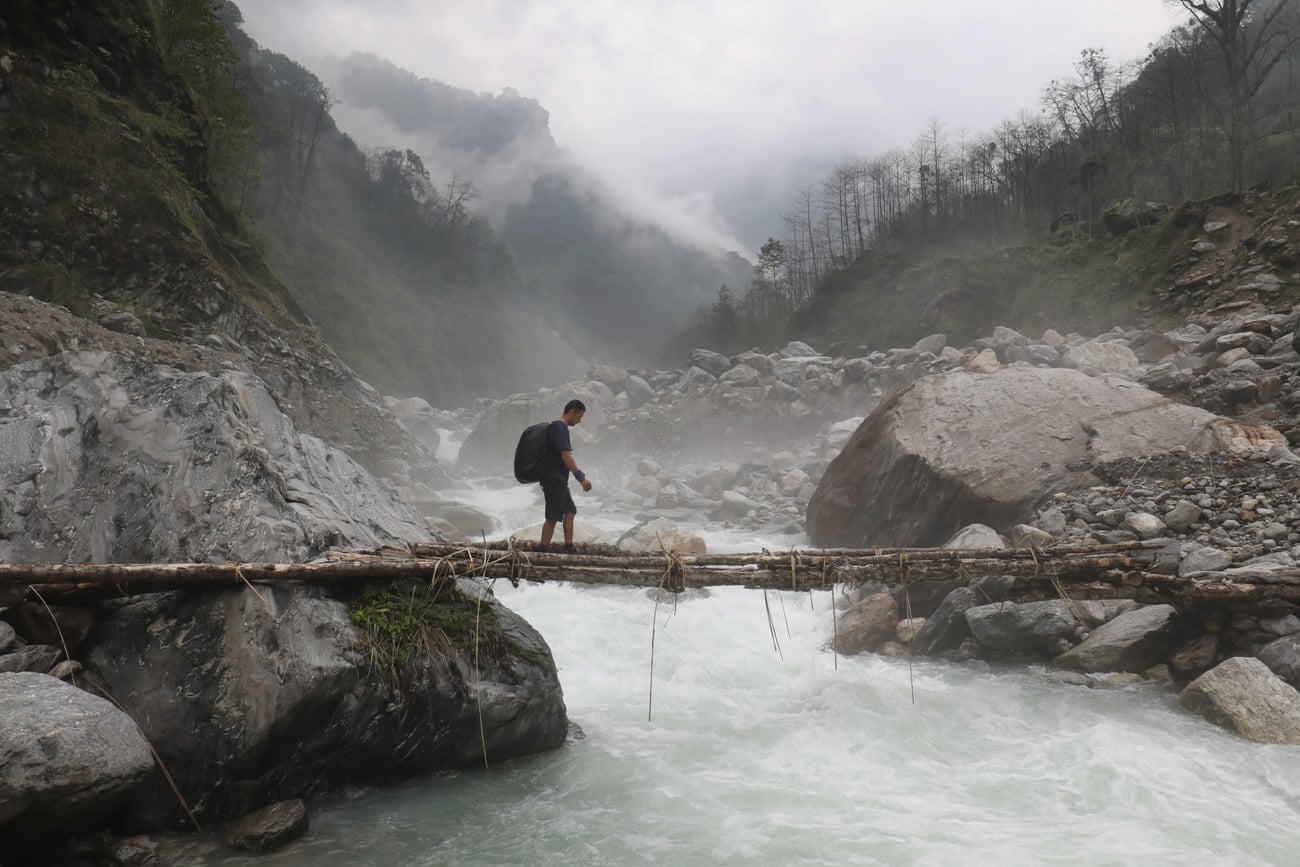
There’s little authentic trekking left on the famous Himalayan trails. But on a hike to a hidden glacier, our writer mucks in with the Sherpas and meets only villagers
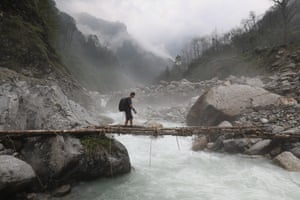
He ate all the rice. He threw rocks at the monkeys. He lied about the toilets and proved pathologically incapable of walking down a trail without veering off on some wild adventure. He sank the raft and brazenly encouraged hard drinking and ribaldry, especially among the old village ladies. Yes, Maila Gurung was undoubtedly one of the finest travel companions I have ever had the privilege to accompany.
He was not even supposed to come with us. We had started from Pokhara in a 4x4, just myself, guide Jagan, Tikka the porter and Chierring, a 19-year-old Sherpa lad from Kathmandu who had never been to the mountains. Pokhara was quiet, the traders eager to bargain. You could buy all the trekking equipment you’d ever need, and at vastly cheaper prices than in Europe. “The brands are mostly fake,” said Jagan, “but the quality is fine – except for high altitudes.”
The idea was to avoid the usual hiking routes, those well-worn furrows that lead to Everest Base Camp or around the Annapurna circuit. Jagan knew them all well: he’d been Everest base camp manager and reached the summit twice. Annapurna was his home patch. “There’s nothing authentic or traditional left on those routes,” he told me. “It’s all for tourists. We’re going to see real Nepal; only a couple of foreigners have been on this route.”
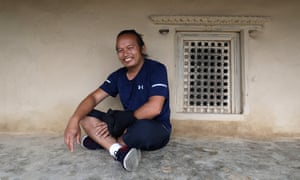
We were dropped off on the boulder-strewn banks of the River Mardi, a deeply scoured Himalayan torrent whose waters end up in the Ganges. Our goal was its source, a hidden glacier right under the Annapurna massif, a six-day trek there and back. Not that we could see much of the country: clouds of imminent monsoon rain were gathering over jungle-clad ridges, all of which had to be crossed. Jagan reminisced about his season as Everest base camp manager. “When Miss India arrived, she brought a hairdryer. Most of the foreigners insist on hot showers, but base camp is on a glacier… every shower helps melt it.”
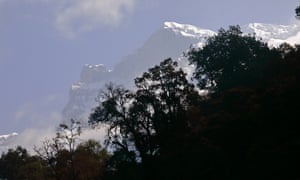
“What do they eat?”
“Pizza.”
“The locals too?”
He grinned. “No way. We eat dal bhat: breakfast, lunch, dinner – always the same.”
Lentils and rice, the Nepali staple diet.
“What will we eat on this trip?”
“Dal bhat.”
That suited me. I didn’t want pizza, hairdryers and hot showers. And so here I was, trudging up 2,000 metres of rice terraces where villagers were just beginning to plant their crops: rice and lentils, of course.
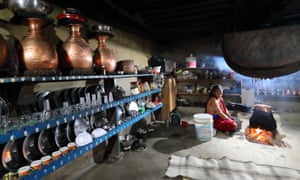
Eventually we merged into a stream of school students heading home and entered the village of Sikles. After five hours of ascent, even on a well-made trail, I was feeling a bit light-headed and wondering if I’d been hasty in judgment, particularly on the pizza.
The village was paved with huge stone slabs. Long flights of steps wriggled up through layers of terraces, where stone houses peeped out through tiny, glassless windows at the magnificent panorama. Opposite a small shop selling essentials was our guesthouse, another stone house surrounded by a flower-decked terrace. And coming out to meet us was the smiling owner: Maila.
Within a few minutes he convinced Chierring that the only toilet was high up the mountain, across three rivers, and challenged everyone to a dal bhat eating competition. First, however, he wanted to show us his village. There were kids chasing chickens, old ladies weaving bags from nettle fibres, and elderly men plaiting floor mats. This was a place of only young or old: many of working age spend years away, returning home rarely. Maila, however, was unusual: he hated cities, loved his village and refused to leave.
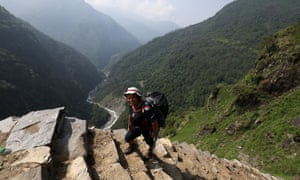
“Have you ever tried pa, our home-made whisky?” he asked, leading us inside one of the houses. We were followed by all the old ladies, who had stopped weaving at the mention of the word pa. The lady of the house was sitting by a fire in the main room, tending a steaming pot.
I was handed a glass and sipped warily, unlike Maila, who wolfed down a tumbler and told a dirty joke. The old ladies began giggling. Some time later, we staggered back to the guesthouse for the dal bhat eating contest. Chierring had accepted the challenge. From the kitchen emerged two trays, each groaning under a mountain of rice. A gong sounded and Maila’s huge paw swept a shovelful of rice and dal into his mouth, followed rapidly by another. Chierring wailed, “Oh, I will lose!” And he did.
Next day, within a mile of the village, we rounded a corner and there, floating above us like a beautiful silver cloud, was Annapurna. Between us and the mountain were a stack of jungle ridges. The path climbed up flights of beautifully cut steps, then swooped down to long suspension bridges. A monkey whooped. Maila threw a rock. “I know that monkey,” he grinned. “He tried to bite me when I was building this path.”
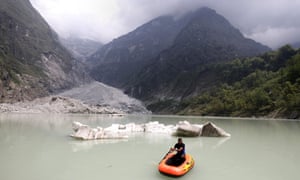
Despite his animosity to that particular creature, Maila proved to be an incredible spotter of wildlife, especially birds, of which there were many, including dozens of minivets, flying in shocking streaks of scarlet and yellow through the trees.
“Monsoon is a good time,” he grinned, flicking away a leech. I, too, could see the advantages: the jungle was decked in orchids, the waterfalls and rivers impressively powerful. Often our feet were invisible under the thick vegetation that covered the path. By late afternoon Annapurna was only occasionally visible through torn black veils of cloud. We crossed a final bridge and arrived at our home for the next two nights, the abandoned village of Hugu.
“Our traditional home,” said Maila, quickly getting a fire going under a thatched shelter. “We moved to Sikles when I was a child.”
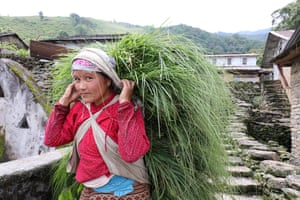
In most circumstances a downpour under leaky thatch might be dispiriting. Not in Nepal. With a good fire going, a kettle boiling and the pa ready, stories began to flow. Jagan told how he started as a porter aged 14, heaving loads of up to 60kg, a practice now outlawed.
That night I lay in my sleeping bag, musing on why this experience seemed so authentic. My conclusion was that we tourists were in the same boat as the Nepalese, sharing the same food and sleeping in the same places. We were comrades. I was carrying some of the food and my own kit.
Next morning we left at dawn for a long, magical day in the shadow of Annapurna, bashing through jungle and clambering over rocks. At noon we reached the glacial lake and launched a one-person pack raft that Jagan was determined to test. I managed to paddle out to an iceberg and stand on it. Maila, however, heavy with dal bhat and merriment, promptly sank. We lit a fire and dried him out.
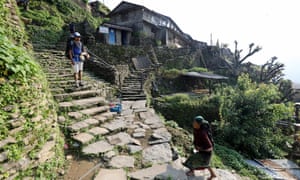
That night, back at our camp, some honey hunters arrived and settled down around the fire with us. Their leader, Meja, refused a tot of pa. “I never drink,” he said. “Not after the leopard.”
Two years before, he said, he had left his wife alone in this same hut with a flock of sheep and gone down to Sikles, where he had drunk pa and failed to return for three nights. Meanwhile, his wife woke to find the hut surrounded by prowling leopards. For the next 72 hours they ate sheep and terrified the poor woman out of her wits. “I swore never to drink again.”
More stories followed in a long, convivial evening. I had reached the real Nepal, I decided, and made lifelong friends.
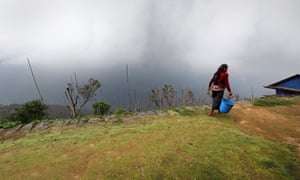
That night I woke in the dark. Everyone was sleeping and the fire was out. A shadow of some creature darted away – not a leopard, but a jungle cat. I stepped outside warily. Far above, the summit of Annapurna appeared to have erupted, a plume of icy sparks shooting out across the heavens. It took me a second to realise it was the Milky Way.
Four days later, back in Pokhara, we all went for dinner. Everyone else had dal bhat, but I ordered pizza, seduced by the smell of cooking cheese. When it came, however, I instantly regretted my choice. Dal bhat was what I really wanted.
The Guardian

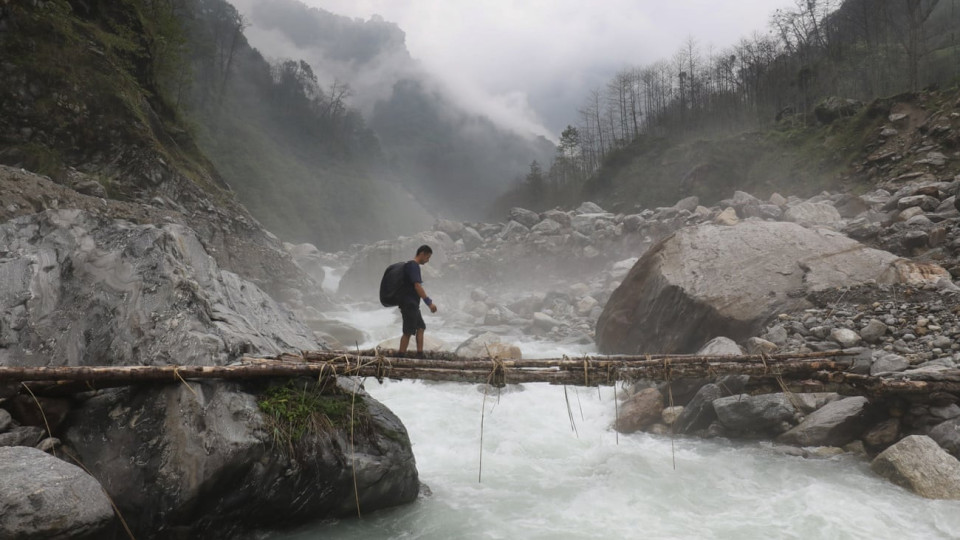
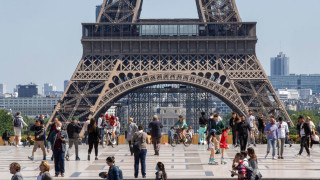








Leave a comment